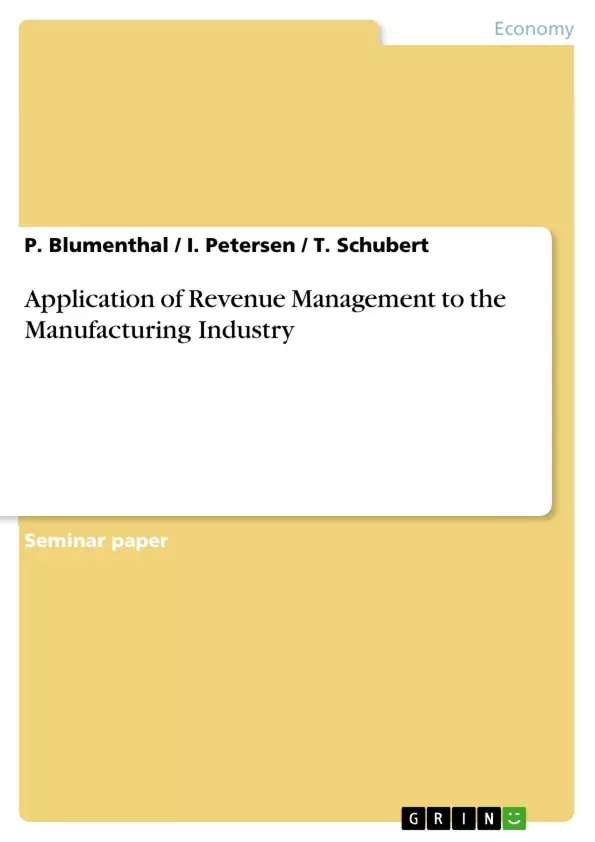Revenue management (RM) is the umbrella term for a set of strategies, tactics and
instruments aiming at the maximization of yield by allocating a company’s capacity to
different customers at different prices. Due to its great success, the application of
revenue management is widespread nowadays. But as the origin of RM lies in the
airline industry, this is still the sector of its main application. Service industries such
as hotels, car-rentals or internet service providers which share the same characteristics
as the airline industry (e.g. fixed capacity and a highly uncertain demand) discovered
quite early the potential of RM. Consequently, they were the first to adopt
RM strategies.1 Retailers, broadcasting industries and companies of the energy sector
have followed lately.
The core concept of RM becomes clear, considering the economics of RM (Cross
1997, p.73ff): The downward-sloping demand curve (figure 1) shows the number of
units of a certain product which are sold at a certain price. [...]
Inhaltsverzeichnis (Table of Contents)
- Introduction
- Problem statement
- Objective
- Basics of Revenue Management
- Definition and Historical Background
- Price- vs. Quantity-based Revenue Management
- Instruments
- Forecasting
- Measuring RM performance
- Requirements for quantity-based RM
- Market
- Company
- Application to the Manufacturing Industry
- Definition of manufacturing
- Applicability in Service Industries vs. Manufacturing Industries
- Market
- Company
- Differences between the service industry and manufacturing
- In-depth look at MTO and ATO
- Implications for the use of RM methods
- Static models for bid-price generation
- Self-adjusting bid-price
- Current use of RM in manufacturing industries
- Case Study
- Setting of the case study
- RM-fitness
- Introduction of the Test Case
- Implementation
- Conclusion
- Future Trends and Challenges
Zielsetzung und Themenschwerpunkte (Objectives and Key Themes)
This work aims to explore the application of revenue management (RM) principles to the manufacturing industry, specifically focusing on quantity-based RM. It examines the potential of RM methods to optimize resource allocation and maximize revenue in manufacturing environments. Key themes explored in the text include:- The definition and historical background of revenue management
- The application of RM methods to manufacturing industries
- The differences between service industries and manufacturing industries in terms of RM applicability
- The development of static and self-adjusting bid-price models for manufacturing environments
- The implementation and evaluation of RM strategies in a real-world manufacturing case study
Zusammenfassung der Kapitel (Chapter Summaries)
The first chapter introduces the problem statement and outlines the objectives of the research. It discusses the challenges of managing resources effectively in a manufacturing setting and the potential benefits of applying RM principles to this industry. Chapter 2 provides a comprehensive overview of the basics of revenue management, covering its definition, historical background, and key instruments. It explores the differences between price-based and quantity-based RM and discusses the importance of forecasting and performance measurement in this context. Chapter 3 delves into the specific requirements for quantity-based RM in the manufacturing industry. It examines the characteristics of the market and the internal capabilities of companies that are conducive to adopting this approach. Chapter 4 focuses on the application of RM to the manufacturing industry. It explores the differences between service industries and manufacturing industries in terms of RM applicability and examines the implications of various production strategies like make-to-order (MTO) and assemble-to-order (ATO) for RM methods. It also investigates the use of static and self-adjusting bid-price models for resource allocation in a manufacturing context. Chapter 5 presents a case study of the implementation of RM principles in a manufacturing setting. This chapter examines the RM fitness of the company, introduces the test case, and analyzes the results of the implementation process.Schlüsselwörter (Keywords)
The key terms and concepts explored in this text include revenue management, quantity-based RM, manufacturing industry, service industries, make-to-order (MTO), assemble-to-order (ATO), bid-price generation, static models, self-adjusting bid-prices, resource allocation, case study, and implementation. These terms represent the core themes and focus areas of the research, highlighting the practical application of RM principles to manufacturing environments.- Citation du texte
- P. Blumenthal (Auteur), I. Petersen (Auteur), T. Schubert (Auteur), 2008, Application of Revenue Management to the Manufacturing Industry, Munich, GRIN Verlag, https://www.grin.com/document/126374



